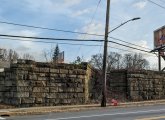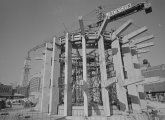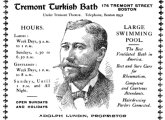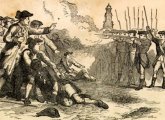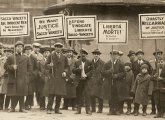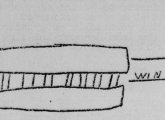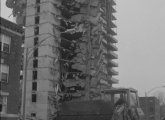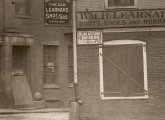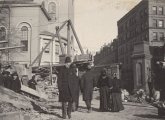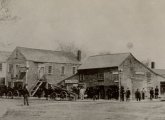Rob Colonna spotted this Purity Supreme shopping cart outside the Quincy Elementary School in Chinatown today. The last Purity Supreme closed in 1997.
A developer is getting ready to build four single family homes off Spring Street in West Roxbury, on a former railroad right of way on which steam locomotives once paused to pick up passengers at a small train stop before thundering across a bridge over Spring Street, hauling commuters from Dedham to Park Square in Boston. Read more.
In 1966, a news photographer captured the construction of the concrete structure around what would become the giant tank at the heart of the New England Aquarium - which opened to the public in 1969, giving us a generation of children who could walk like a penguin: Read more.
Long, long before the AMC Boston Common went up at the corner of Tremont and Avery streets, the site was the home of the Tremont Theatre, where an enterprising Swedish immigrant put in a swimming pool and a Turkish bath in the basement - open all night, at least for men. Read more.
The City Council will consider a measure to permanently honor Crispus Attucks, the first man to die in the Boston Massacre. Read more.
On March 1, 1925, people who supported a new trial for Nicola Sacco and Bartolomeo Vanzetti, convicted of a 1920 robbery turned double murder in Braintree, marched through the North End and Scollay Square for a rally at Faneuil Hall, where Boston City Council President James Moriarty joined their cause. Read more.
Writing in the Pilot, Thomas Lester explains how the main route between Roslindale and Mattapan squares was named for Roslindale's first Catholic pastor, who helped set up what is now Sacred Heart Church on Brown Avenue at what is now one of Boston's non-highway highways.
In 1954, 46 Winchester St. in Bay Village was home to the Latin Quarter nightclub.
Until very recently, it was an unassuming parking lot that doesn't look at all like the sort of spot that would play a role in transgender history and Boston's mid-20th-century reputation as a center of puritanical small-mindedness (and now it's nine-unit luxury townhouse): Read more.
In the 1950s and 1960s, a unit at Wright-Patterson Air Force Base in Ohio, collected and investigated UFO sightings - including a number in the Boston area (two in West Roxbury alone). Read more.
On the Channel considers and reviews the Summer Street Steps and wonders how, with all the billions of public and private dollars poured onto the blank slate that used to be the Seaport, that's what we wound up with - complete with loudspeakers pumping out pop music like some mall in the 1990s. Read more.
On Jan. 25, 1971, a nearly finished 16-story apartment building at 2000 Commonwealth Ave., near Boston College, collapsed, killing four construction workers and injuring a couple dozen more in a slow domino-like pancaking that started with a roof collapse. Read more.
Artair Geal discovered these 1980s ads for Prime Computer, which turned the old Carling Brewery on the shores of Lake Cochituate into a minicomputer powerhouse, and which apparently dabbled in romance advice on the side: Read more.
On the Channel explores the pothole that just keeps getting bigger on Thomson Place, an increasingly busy Fort Point Street because Boston Public Works won't fix it, not because the department is shirking its duties but because of the street's oddball status as a private way. With a detailed history of why the street remains a private way, going back to the turn of the 20th century.
The Boston Landmarks Commission resorts to pesky facts to show that the Boston Stone might have had a more mundane origin than being the point to which all Boston-area mile markers refer - although it is possibly an indicator of how long Masshole drivers have been around: Read more.
The Boston Institute for Nonprofit Journalism recounts the saga of Charles Taylor, a native Liberian who went to Bentley and lived in Roxbury, returned to Liberia to become a government official, fled after he was charged with embezzlement, was picked up by US marshals and put in the Plymouth House of Corrections, from which he escaped in 1985 to become the leader of a bloody campaign to become the country's dictator.
Aline Kaplan recounts the transformation of what had been a way for men to relieve themselves in private rather than in the Frog Pond into today's Earl of Sandwich.
In December, 1895, construction of what would be the nation's first subway was well under way along and under Tremont Street, but that didn't stop busy Bostonians from making their rounds.
Compare to the view today: Read more.
In 1856 or thereabouts, A.H. Folsom photographed the northwest corner of the intersection of Warren and Dudley streets in Roxbury.
The view of that corner today: Read more.
After protesters dumped the tea into the harbor 250 years ago, they tossed the chests it had been in into the harbor as well. J.L. Bell posts a copy of an account by Rev. Dr. John Prince of Salem, who watched the Tea Party and then returned to the wharf the next morning: Read more.
- ‹ previous
- 3 of 98
- next ›


